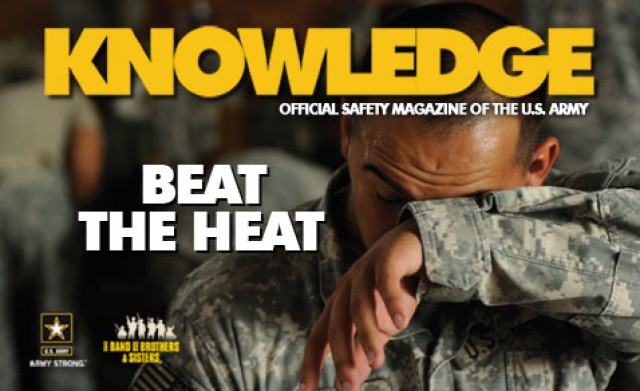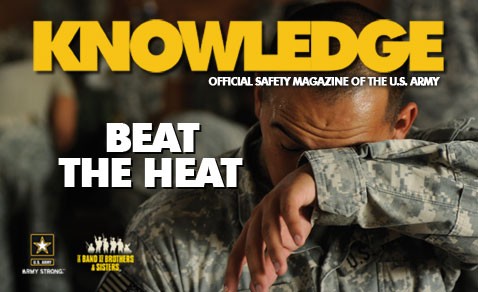From the first day of our military careers, the Army has stressed the importance of preventing serious heat illnesses. Despite these warnings, hundreds of Soldiers still suffer from heat illnesses each year.
In 2008 alone, there were 299 hospitalizations for heat stroke and 1,467 hospitalizations for heat injury/exhaustion. In addition, over the past 20 years, the incidence of heat stroke in the Army has increased sevenfold.
What can Leaders do'
There are several preventive measures Leaders can take to reduce the risk of serious heat illness in their Soldiers. For example, training schedules should be arranged so the most physically strenuous activities take place in the early morning, not during the hottest part of the day. Likewise, strenuous activities should not be scheduled back-to-back. There is a cumulative effect of repetitive days of training in warm or hot conditions; therefore, Leaders might also need to modify training based on the prior day's weather and the Soldier's activity level.
A Soldier's physical activity intensity and clothing/equipment might also need to be adjusted for the weather conditions. Altering clothing and equipment guidelines, such as unblousing boots and exchanging Kevlar helmets for patrol caps, can help a Soldier stay cool. In addition, Leaders should consider changing the order of training events and providing cooling stations between them.
When a Soldier suffers a heat-related injury, the unit's Leaders need to watch their other Soldiers for symptoms of heat injuries. Often the first Soldier to succumb is a warning that others might follow. Leaders should also be aware of the overall health of their Soldiers, and Soldiers need to communicate health concerns to their superiors. Prior exertional heat injury and certain chronic conditions or medications can increase a Soldier's risk of becoming a heat casualty, so Soldiers should share this information with Leaders.
What can Soldiers do'
The prevention of heat casualties is not just a Leader's responsibility. The individual Soldier has an obligation to do what he or she can to mitigate the risk, and that starts with taking care of their bodies. A male Soldier who is out of shape, as indicated by a two-mile run time greater than 16 minutes, is at three times the risk of suffering an exertional heat injury - as is a Soldier who is overweight. A Soldier who is both out of shape and overweight is at eight times the risk of suffering an exertional heat injury. Preparing for the heat starts with a year-round approach to maintaining physical fitness and a healthy body weight.
Acclimating to the heat is also critical to preventing heat injuries. An acclimated Soldier's body temperature during activity is lower and sweating begins sooner and at a higher rate. This improves heat loss. Complete heat acclimation requires up to two weeks of daily progressive heat exposure and physical exercise for at least 100 minutes per day. A highly fit Soldier is already partially heat acclimated and acclimates faster than a less-fit Soldier, which is another reason they should maintain a high level of physical fitness. Take note that acclimation begins to degrade with lack of exposure to the heat in as little as one week.
Proper hydration
The more a Soldier sweats, the more fluids he needs to maintain proper hydration. Dehydration negates many of the advantages gained through being fit and acclimated to the heat, reducing physical work capacity and increasing body temperature and the risk of becoming a heat casualty. Proper hydration should not only occur during training, but also continue throughout the day so the Soldier starts the next training day properly hydrated. (Editor's note: For more information on proper hydration, see the article "Get to Know H2O" on page 8.)
Heat illness treatment
If a Soldier suffers a serious heat illness, cooling the body rapidly is of paramount importance. While dehydration can contribute to heat stroke incidence, replacing fluids is secondary to cooling a heat stroke victim. Wrap iced sheets (bed sheets soaked and stored in ice water) around a hyperthermic Soldier to provide rapid cooling in the field. This can reduce heat stroke mortality from 50 to 5 percent.
Personnel at the U.S. Army Research Institute of Environmental Medicine (USARIEM) are actively engaged in developing new preventive measures to mitigate heat stress for the Soldier. By their very nature, certain training events could increase a Soldier's risk of hyperthermia, so an efficient and practical cooling method is necessary. USARIEM is developing an Arm Immersion Cooling System (AICS), which is designed to provide rapid cooling during rest breaks or after training events where heat stress is high. The AICS can help reduce body temperature by 1 to 2 F in 8 to 10 minutes and accommodate up to six Soldiers at a time. This can be used as part of an integrated composite risk management approach to reducing the incidence and severity of heat illnesses throughout the military.
Serious heat illnesses are preventable, but doing so requires a two-pronged approach. Officers and NCOs must plan and conduct training in a manner that minimizes the risk of serious heat illness. Soldiers must heed their Leaders' advice and prepare themselves for the hot months ahead. When we take the time to prepare, there's no reason we can't beat the heat.
Additional information on heat injury prevention can be found on the U.S. Army Institute of Environmental Medicine Web site at http://www.usariem.army.mil/pages/downloads.htm and the U.S. Army Center for Health Promotion and Preventive Medicine's heat injury prevention page at http://chppm-www.apgea.army.mil/heat/.


Social Sharing